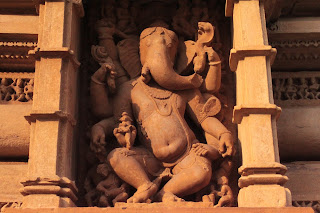I visited Khajuraho for 2 days back in 2010. I had heard a lot about the famed temples of Khajuraho, known all over the world for their beautiful sculptures of Hindu gods and goddesses, as well as for their erotic sculptures, and I was very keen on seeing them. I managed to see around 10 of the temples on my visit, including all the very well known ones. I flew down from Delhi and I stayed at one of the town's top hotels, Clarks Khajuraho. It was a fascinating visit.
Khajuraho
lies in the central Indian state of Madhya Pradesh and the town has about
25,000 inhabitants (2011 census). It is famous for its Hindu and Jain temples
and their erotic sculptures. The Khajuraho
Group of Monuments have been a UNESCO World Heritage Site since 1986, and most
of them were built between 950 AD and 1050 AD. There were originally about 85
temples but only around 25 have survived.
The monuments were built by the Chandela
Dynasty. Their kingdom was later known as Bundelkhand.
The Chandela
Dynasty’s capital was in Mahoba, and the Khajuraho temples
were built about 50 km from them. Most of the temples were built by the kings Yashovarman, Dhanga and
Vidyadhara.
The temples are clubbed in three groups, the western group, the eastern group
and the southern group. The western group temples are the most visited ones.
The temples were actively used till
the end of the 12th century, after which the Chandela Dynasty was defeated by the Delhi Sultanate
under Qutb-ud-din-Aibak.
Under various Islamic dynasties, the temples suffered significant damage over the
next few centuries and were almost forgotten.
In the 1830s, the temples came to
prominence after a British surveyor discovered them with the help of local
Hindus. Subsequently, Khajuraho went on to become a very popular
tourist attraction, both with Indian and global travelers. To cater to the
large number of tourists, Khajoraho has
very good infrastructure, with flight connections to Delhi and Varanasi, as
well as top hotels like Ramada Khajuraho,
The Lalit
Temple View, Radisson Jass Hotel and Clarks Khajuraho,
plus numerous budget hotels.
Kandariya Mahadev Temple is
the largest of Khajuraho’s temples. It was
built in the reign of King Vidyadhara, and was completed
in 1029 AD. It is dedicated to Shiva. It stands in the western group of
temples. The temple’s tower stands at a height of 31 meters. The exterior of
the temple is covered with sculptures. These include erotic sculptures and
sculptures of gods. There is an informative sound and light show that takes place in the evenings, both in English and Hindi, outside the temple.
 |
| Kandariya Mahadev Temple |
 |
Erotic Sculpture with Upside Down Male Figure,
Kandariya Mahadev Temple |
 |
| Erotic Sculpture, Kandariya Mahadev Temple |
Lakshmana Temple was
completed in 939 AD. It is dedicated to Vaikuntha
Vishnu, a four headed depiction of Vishnu. It is a part of the western group of
temples. The exterior of the temple features divine sculptures as well as
erotic sculptures, some featuring erotic scenes involving animals.
 |
| Lakshmana Temple |
 |
| Ganesha, Lakshmana Temple |
 |
| Apsara, Lakshmana Temple |
 |
| Erotic Sculpture, Lakshmana Temple |
 |
| Erotic Sculpture with a Horse, Lakshmana Temple |
Vishvanatha Temple
was completed in 999 AD and is dedicated to Shiva. It was commissioned by King Dhanga. It is part of the
western group of temples. The architecture resembles that of the older Lakshmana Temple and the more
recent Kandariya Temple. The walls
feature erotic sculptures.
 |
| Vishvanatha Temple |
 |
| Erotic Sculptures, Vishvanatha Temple |
Varaha Temple
was completed in 950 AD. It has a large monolithic sculpture of Varaha, the boar
incarnation of Vishnu. The large statue of Varaha
has a height of 1.7 meters and a length of 2.6 meters.
 |
| Varaha Temple |
Nandi
Temple dates back to 1000
AD and has a large monolithic Nandi statue, dedicated to the bull of Shiva.
 |
| Nandi Temple |
Parshvanatha Temple was
built in 954 AD. It was built by a Jain family during the rule of King Dhanga. It is the largest
among the town’s Jain temples. The temple walls have sculptures of celestial
beings. Despite being a Jain temple, there are also Hindu sculptures centred
around Vishnu and his incarnations.
 |
| Parshvanatha Temple |
 |
| Celestial Couple, Parshvanatha Temple |
Matangeshvara Temple dates back to 1000
AD. It lies in the western group of temples. It is the only Hindu temple in Khajuraho stll used for active
worship and has a large 2.5 meter high linga.
 |
| Matangeshvara Temple |
 |
| Linga, Matangeshvara Temple |
DuladeoTemple goes
back to 1125 AD. It is dedicated to Shiva. It was the last of the temples built
by the Chandela Dynasty. The walls
have sculptures of celestial dancers in erotic postures. It is part of the
southern group of temples.
 |
| Duladeo Temple |
 |
| Celestial Figures, Duladeo Temple |
Adinath Temple is
a Jain temple going back to 1027 AD. It is dedicated to the Jain Tirthankara Adinatha.
 |
| Adinath Temple |
Chitragupta Temple was built in 1023
AD. It is dedicated to the sun god, Surya, and has a tall sculpture of him
riding a chariot of seven horses.
 |
| Chitragupta Temple |
Khajuraho was fascinating. I was mesmerized by the beauty of the temples; the sheer age of the structures and the fact that they have gracefully survived the passage of time with minimal damage; the intricate detailing of the sculptures; and the fact that even in that era, our ancestors were open enough to graphically depict eroticism in such a beautiful and artistic manner, when even a thousand years later, most of us are so squeamish and embarrassed about it!




















No comments:
Post a Comment